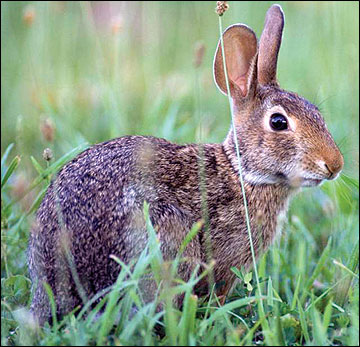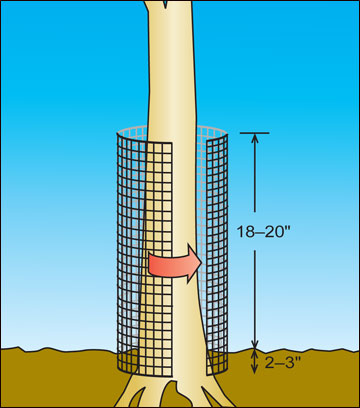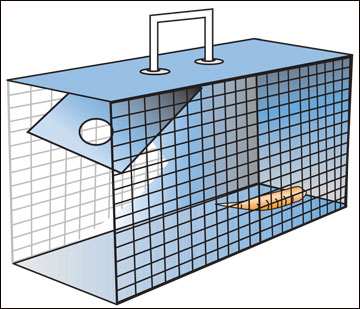Cottontail rabbits (Sylvilagus floridanus) are one of the most common game animals in Missouri (Figure 1). Cottontails begin to breed in late winter and early spring and have a gestation period of about 28 days. Litter sizes average three to five young and cottontails can typically produce four to five litters each year. Females will build a softball-sized nest for each new litter and line it with fur and grasses.
Rabbits prefer brushy cover interspersed with open areas of grasses and herbaceous broad-leaved plants, or forbs. Brushy fence rows, woody stream banks and woodland borders provide excellent protective cover, and nearby forbs provide summer foods. In winter, when food is scarce, rabbits will clip twigs and gnaw the bark of woody plants. Landscaped yards provide excellent rabbit habitat, which accounts for how common cottontails are in suburban and urban areas. Cottontails have small home ranges and spend most of their lives in areas of 1 to 5 acres with good habitat.
Some people enjoy seeing rabbits around their lawns, whereas others wish to keep rabbits away to protect crops, gardens or landscaping. Even people who enjoy rabbits may need to control them if they begin causing damage. Rabbits are opportunistic feeders that will eat readily available plants during spring and summer.
Before taking measures to prevent or control wildlife damage, you need to correctly identify the animal responsible. This guide describes how to identify rabbit damage and measures to prevent and control it.
 Figure 1
Figure 1
Cottontail rabbits are a valuable game species in Missouri, but in some cases they can be a nuisance by damaging plants, garden crops and newly planted seedlings.
Identifying rabbit damage
Rabbits can cause damage throughout the year, depending on what plants are available. They eat succulent green vegetation, such as flowers, vegetables and crops, during the growing season, and they may turn to trees or shrubs in winter. Rabbits commonly bite off small branches and gnaw to reach the green inner bark. Rabbits can severely damage landscape plants, orchard trees and other woody plants, especially during long periods of snow cover.
Identifying damage caused by rabbits is not difficult. Cottontails are active during the day, so they can be easily observed during their daily activities. They leave signs, including pea-sized droppings and tracks often left in pairs. They also often bite off young plants or small twigs cleanly at a 45-degree angle. In contrast, deer lack upper incisor teeth and leave a jagged, torn edge on the plant (Figure 2).

 Figure 2
Figure 2
At left, cottontails' front two teeth cleanly cut stems of plants at a 45-degree angle. At right, plants browsed or clipped off by white-tailed deer have more jagged edges.
Prevention and control methods
If rabbits become a nuisance on your property, you can take a variety of measures to reduce the risk of damage to your plants, trees or shrubs. Each of the prevention and control methods described below has advantages and disadvantages, so a combination of methods will be most effective. Before you begin a damage management program, however, weigh the time and cost of control against the damage the rabbits could cause.
Exclusion
Rabbitproof fences offer practical and inexpensive protection for small areas. You can exclude rabbits from vegetable and flower gardens, nurseries and ornamental plants with an 18- to 24-inch-high fence of 1-inch wire mesh. The bottom edge of the wire must be staked to the ground or buried several inches to prevent rabbits from burrowing under the fence. Perimeter fences of welded wire of at most 1-inch-by-2-inch mesh will keep rabbits out of larger areas as long as they are well maintained (Figure 3).
Tree-trunk guards are an effective means of preventing damage to individual trees and shrubs. One type is an 18- to 24-inch-high cylinder of 1/4-inch mesh hardware cloth set into the ground around the trunk to prevent gnawing damage to the main stem or trunk (Figure 3). Multistemmed shrubs should be encircled with hardware cloth or 1-inch wire mesh. You can also use plastic guards or tubes to protect newly planted woody shrubs, trees or fruit crops (Figure 4). These can also be used to protect valuable plants from deer as well as rodents, such as meadow and prairie voles. For more temporary protection, you can use flexible polypropylene netting, galvanized poultry wire or various types of paper, plastic or tinfoil wraps.
 Figure 3
Figure 3
Plastic tree guards or tubes protect young seedlings, shrubs or newly planted vegetation from rabbits.
 Figure 4
Figure 4
A cylinder of hardware cloth or other wire mesh can protect trees from rabbit damage.
Habitat modification
Cottontails will not survive long without access to quality habitat that provides thick protective cover and ample food. Remove brush piles, debris, weed patches, rock piles and other types of cover that rabbits may use as escape cover. Remove escape cover next to newly planted woody ornamentals, other woody plants, vegetable gardens or ornamental landscape plants. Mowing or using labeled herbicides to control woody vegetation can also help modify the habitat and make the area less suitable for rabbits.
Repellents
Several repellents are available to keep rabbits away from your plants. Repellents can provide temporary protection from damage, but their overall effectiveness varies. Label restrictions on most products suggest you limit use to woody plants during winter months when rabbits are most likely to cause damage. Most repellents are unsuitable for use on garden crops meant for human consumption. Always follow all label directions when handling or applying repellents.
Repellents fall into two categories: taste-based and odor-based. Taste-based repellents make plants distasteful and are contact repellents that must be applied directly to the plant. Examples include products containing capsaicin, or hot pepper extract, or those based on the fungicide Thiram. These products are water-soluble and usually need to be combined with a sticker solution to retain their effectiveness. Without a sticker solution, repellents must be reapplied after rainfall or as the plant grows.
Odor repellents work by keeping rabbits away from an area with a foul smell. Many use a mix of odors created by garlic, eggs, or ammonium or potassium salts of soaps to create a repellent scent. These repellents are often applied directly to the soil around the perimeter of an area to be protected.
Rabbits can build a tolerance to repellents, eventually making them less effective. Because of the necessity of reapplication and rabbits' potential tolerance, repellents can be an expensive option.
Hunting
Rabbits are a game species in Missouri, so hunting rabbits may be an option where local laws permit the use of firearms during the hunting season. Hunting during the legal rabbit season can help landowners control rabbit numbers. Contact the Missouri Department of Conservation for information on managing rabbit populations during other times of the year.
Trapping
Live trapping can be used to remove individual animals causing damage. Cottontails can be captured with a variety of live traps, including wood box traps or wire traps (Figure 5). Plans for building a wooden box trap can be found in the Additional resources section. The effectiveness of summer trapping is limited because of the number of rabbit young and the difficulty of baiting rabbits into traps when food is abundant. Winter live trapping may be more effective because food is scarcer, especially during periods of snow. Areas with signs of rabbit activity, such as tracks or woody plants that have been gnawed on, are logical places to set live traps. Rabbits live in areas with plenty of escape cover — brush piles, briar patches and thick fence rows — and also prefer areas with low-cut bluegrass mixed with clover and shrubs. To catch rabbits, place traps in or along rabbit runs or trails. Carrots, corn, apples, and dried clover and other legumes are the most effective bait for trapping rabbits.
 Figure 5
Figure 5
Cage traps can successfully remove problem rabbits, particularly during winter when food is scarce. A trap's door should be at least 7 inches tall, and the trap should be baited with fresh carrots, lettuce, apples or clover.
Conclusion
Cottontail rabbits rarely cause severe damage, but you can take steps to control rabbit populations if they become a nuisance. Using a combination of prevention and control techniques usually reduces damage and solves the problem.
Cottontails are a valuable game species in Missouri and are covered under the Wildlife Code of the Missouri Department of Conservation. Rabbits can be hunted during legally established seasons in the fall and winter. When rabbits are causing damage, contact the Missouri Department of Conservation for permission to live trap or control rabbits at times outside the legal hunting season.
Additional resources
- Missouri Department of Conservation
- Cottontail rabbit control
https://mdc.mo.gov/wildlife/nuisance-problem-species/cottontail-rabbit-control
- Cottontail rabbit control
- Wildlife Code of Missouri